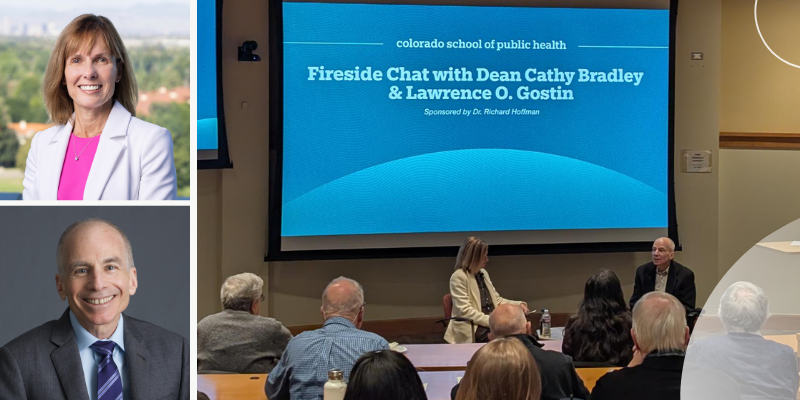A term like “environmental threats” conceals the concrete effects the dangers might pose to humans. For example, heat waves, dwindling water supplies, more frequent and intense fires, and air pollution make communities less livable, threaten human health, and put pressure on local economies. Because these stressors affect us all, it makes sense to identify the greatest threats they pose and seek effective responses to them from all community members.
That’s the premise of a two-year, National Institutes of Health-funded grant that recently concluded its first phase. The project united Colorado School of Public Health (ColoradoSPH) leaders, scientists, policy experts, and residents of five counties in the San Luis Valley and six West Denver neighborhoods. Their common quest: understand the impacts of heat, drought, wildfires, and deteriorating air quality, and find effective ways to respond and build healthier, more resilient communities.
The effort recently produced an array of resources, packaged as the Mountain West Hub. ColoradoSPH associate professors Katie Dickinson and Kathy James launched the project as principal investigators in 2023. The two, who have long connections to the West Denver and San Luis Valley communities, respectively, led an 11-member team, which included faculty from the Department of Environmental and Occupational Health (EOH) the Centers for Health, Work & Environment (CHWE), the Center for Public Health Practice, (CPHP) and National Jewish Health.
Amplifying voices of the communities
The ColoradoSPH team worked in concert with four advisory boards, comprised of experts in climate science and policy and practice, as well as residents and professionals in the San Luis Valley and West Denver communities. The members of each of these advisory boards took part in multiple interviews that yielded insights about the effects of environmental threats in the two communities. The Mountain West Hub team summarized these findings and made recommendations for change in a bilingual report titled “Community Voices, Volume 1.” (report in Spanish)
The content on the Mountain West Hub does not stop with the report. It includes maps, definitions of environmental stressors, educational modules on drought, heat waves, air quality, and wildfires, and a collection of resources in both English and Spanish.
“The result of the work is a series of very pragmatic tools that were designed to be utilized by a host of different audiences that we engaged with in Denver and throughout the San Luis Valley,” said Craig Kapral, project manager for the Mountain West Hub and a senior research assistant with EOH and CHWE. “The focus was to be able to get the word out so that anybody can get a sense of what these products are and get their eyes on them.”
Kapral emphasized that the ColoradoSPH team relied on “the expertise and contextualized knowledge” of the community advisory boards in designing and deciding how to disseminate the products for the Mountain West Hub.
Deputy director of the CHWE and Mountain West Hub principal investigator Carol Brown reinforced his point.
“We met with the groups on an ongoing basis throughout the project to identify their priorities, determine what the communities would be interested in, what would meet their needs, and develop projects together,” Brown said. A key consideration was to ensure that the materials the groups created were not only evidence-based, but also “accessible to a non-academic audience,” she said.
Multiple paths for spreading information
That familiarity with the diverse communities drove decisions about how to spread information from the Mountain West Hub, Kapral noted. The methods included distributing printed flyers, developing inserts for newspapers, attending organizational meetings, and making contacts at special events, such as the Crane Festival, which celebrates the migratory arrival of sandhill cranes in the San Luis Valley.
“We’ve also tailored some of our materials,” Kapral noted. For example, information for health care clinics centers on the effects of extreme heat on agricultural workers, he said.
Staff of the CPHP, directed by Dr. Cerise Hunt, a member of the ColoradoSPH Mountain West Hub team, also met with Kapral to learn about the project and will have future meetings to discuss ways to disseminate information about it.
“They all want to help to distribute the program,” Kapral said, adding that “scientific colleagues” within ColoradoSPH and other health care organizations could also provide useful input.
“We are trying to incorporate a broad range of dissemination activities with input and guidance from our community partners,” Kapral said.
Helping to develop community resilience
The crux of the project is helping communities develop strategies for resilience in the face of challenges. In the San Luis Valley, those largely center on facing drought and the depletion of water resources, while in West Denver, they focus on addressing air quality issues and adapting to extreme heat. But environmental stress-induced problems can cross geographic boundaries, Brown noted.
“Drought affects West Denver too,” she said. For example, a goal for the communities there is to create more green space, which will require more drought-resistant plants. The San Luis Valley and West Denver communities both deal with health threats created by heavy wildfire smoke, Brown added.
“The groups are finding these common stressors and barriers,” she said. “Being able to talk about how they address them differently in their communities has been another cool part of this project.”
The importance of sustaining attention to climate issues
Going forward, the project plans to create a “Community Voices, Volume 2” resource that includes video stories from residents about environmental issues, resilience strategies, and efforts to improve health for all, Kapral said.
He added that “building sustainability into all the work” of the project is a key goal. For example, the West Denver Community Advisory Board has worked to solidify connections with residents, businesses and other leaders involved in the West Area Plan, which was approved by the Denver City Council in 2023 to guide development in West Denver’s six neighborhoods. Goals include heat relief for low-income residents and adding trees to parks and trails.
The West Area Plan, which is part of Denver’s work on climate action, sustainability and resilience, and the involvement of West Denver Community Advisory Board members in it, is “an example of building sustainability by connecting people, resources, and knowledge, and putting the plans to paper,” Kapral said.
A helping hand for community advocates
Brown underscored that the ColoradoSPH team helped the San Luis Valley and West Denver communities build on, extend, and sustain work they had already initiated to address environmental threats.
“It’s been informative to see what all the communities were already doing. We didn’t instigate it,” she concluded. “We were able to come in and start working with people and bring some resources.”
“What I’ve taken away is a deep appreciation for the knowledge, resources, and expertise that exists within these communities,” Kapral added. “I’ve seen the passion around this work and its importance, not just for now, but for future generations.”






